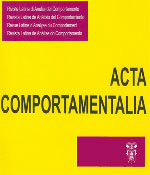Efeitos de diferentes histórias de reforçamento e extinção sobre a variabilidade comportamental
Contenido principal del artículo
Resumen
Os objetivos desse trabalho foram (1) comparar a variabilidade comportamental controlada por duas diferentes contingências de reforçamento positivo (2) observar se a ordem de exposição a essas contingencias interfere na aquisição e na manutenção da variabilidade, e (3) verificar como a extinção interfere no padrão de reaquisição da variabilidade. Quatorze ratos foram divididos em dois grupos, que diferiram entre si devido à ordem de exposição a duas contingências (LAG-5 e RDF), apresentadas de acordo com o delineamento ABACA ou BABCB, onde A correspondeu à contingência LAG-5, B à contingência de RDF e C à extinção. Foi avaliada a variabilidade na emissão de sequências de quatro respostas em duas barras. Os resultados indicaram sensibilidade diferencial às diferentes contingências de reforçamento da variação, sendo sua aquisição e manutenção controladas principalmente pela contingência em vigor, com pouca interferência da história de reforçamento. Além disso, a condição de extinção se mostrou indutora de variabilidade, não interferindo, porém, no controle operante da mesma. Os conceitos de ressurgência, otimização e maximização são considerados na análise desses dados.
Detalles del artículo
Cómo citar
Takashi Yamada, M., & Laite Hunziker, M. E. (2010). Efeitos de diferentes histórias de reforçamento e extinção sobre a variabilidade comportamental. Acta Comportamentalia: Revista Latina De Análisis Del Comportamiento, 17(1). Recuperado a partir de https://revistas.unam.mx/index.php/acom/article/view/18138
Citas en Dimensions Service

<a rel="license" href="http://creativecommons.org/licenses/by-nc-sa/4.0/"><img alt="Licencia de Creative Commons" style="border-width:0" src="https://i.creativecommons.org/l/by-nc-sa/4.0/88x31.png" /></a><br />Este obra está bajo una <a rel="license" href="http://creativecommons.org/licenses/by-nc-sa/4.0/">licencia de Creative Commons Reconocimiento-NoComercial-CompartirIgual 4.0 Internacional</a>.
